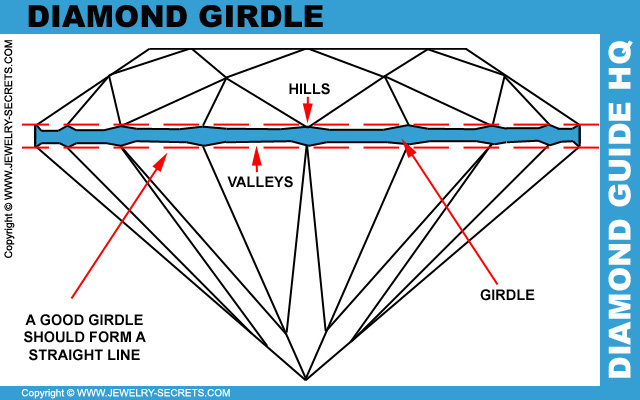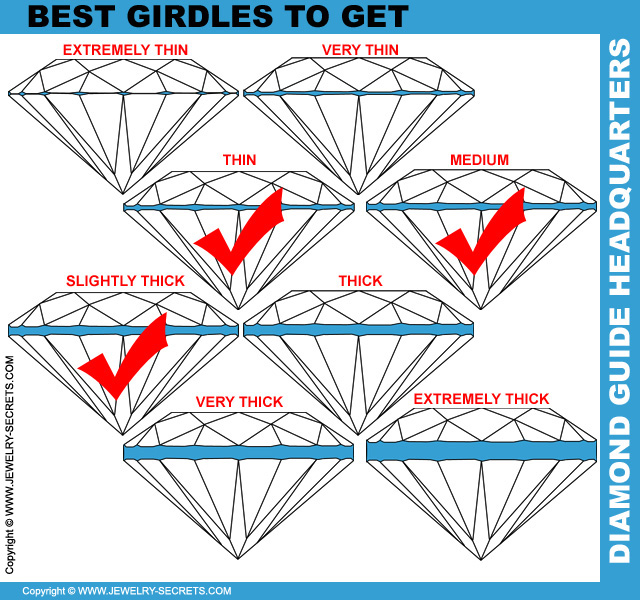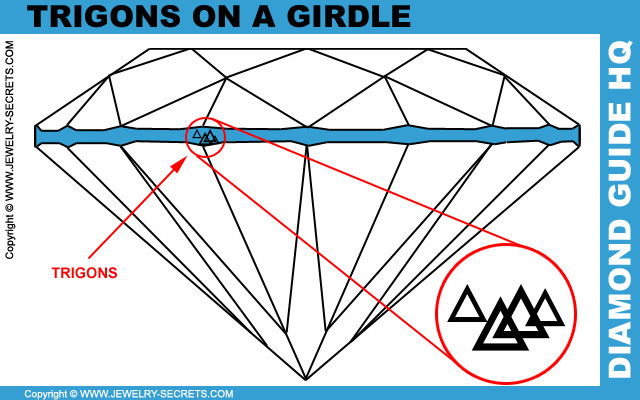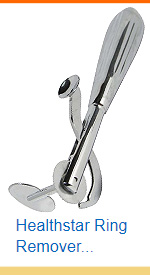DIAMOND GIRDLE
LEARN ALL ABOUT THE GIRDLE OF A DIAMOND
This post contains affiliate links. If you use these links to buy something I may earn a commission. Thanks! As an Amazon Associate I also earn from qualifying purchases.

What is a diamond girdle?
A girdle is the thin rim that runs around the entire outside of your diamond.
It’s easier to see if you turn your diamond sideways and look at it. The girdle is like a belt that divides the top portion of the diamond (called the crown), from the bottom portion of the diamond (called the pavilion).
If you look closely enough, you’ll see that the girdle is not a straight line. It’s made up of hills and valleys that slope up and down to meet the upper girdle facets and the lower girdle facets.
See image below…

Many dismiss the girdle as insignificant, but I’m here to tell you, you shouldn’t.
The girdle can play a huge role in how the diamond looks, reacts to light, how well the diamond is cut, how durable the diamond is and how easy it is to set the stone. The girdle is that important!!!
It’s also a fact that the girdle is the weakest part of the diamond. When you nick, chip or break a stone, 95% of the time it’s right on the girdle. And most of the chipping can actually be prevented… If you know what to look for.
Still think the girdle doesn’t matter? Read on…
Different types of girdles
There are 3 main types of diamond girdles that full cut (58 facet) diamonds can have. They are:
- Bruted
- Polished
- Faceted
Let’s take a closer look at them.

Bruted girdles
A bruted girdle is a diamond in the rough. It’s part of the diamond that’s raw, natural, untouched and unpolished by man. A bruted girdle is what the entire diamond would look like before the cutting and polishing process. Bruted girdles can look frosty, white, grainy and rough.
Usually this factor isn’t a big concern unless the girdle size gets large enough where this roughness would stand out like a sore thumb.
Plus, if the roughness of the bruted girdle gets too rough or bumpy, it will trap dirt in the pores and make the edge look dark and dingy. Dirty girdles are not cool.
The one great trait about a rough girdle is the fact that it makes them easy to hold onto. The prongs of a mounting or ring can grip the edges well.
Polished girdles
A polished girdle looks clean and smooth all the way around. No facets, no roughness, just a clean, smooth strip that circles the outer perimeter of the stone.
Polished girdles are wonderful because they aren’t distracting and don’t trap dirt. But they do tend to get slippery when trying to hold them in a mounting, prongs or diamond tweezers (they can pop out pretty fast).
The most common girdle found on any diamond is the faceted girdle…
Faceted girdles
A faceted girdle is cut and polished just like the rest of the diamond. It distributes vertical facets around the outside edge that help continue the flow of the faceted diamond from head to toe. You don’t notice the girdle is there because it reflects light and blends in with the rest of the stone.
Faceted girdles also make it easy to set in a mounting and hold with tweezers. The flat edges make it easy to grip and secure the stone.
I love faceted girdles the best, but once a diamond gets set in a ring, you really won’t notice the girdle much anyway, unless you are viewing the stone from the side.
Normally the only time you’ll notice the girdle is if the girdle is an eye sore, or if the girdle is chipped or broken.
Both of these are attributed to one thing: The thickness of the girdle.
So let’s look at the different girdle thicknesses so you can see what the grades are and what thickness of girdle you should buy.
Do note that the girdle’s thickness is taken from the valleys of the girdle which is the narrowest section of the cut as shown in the image below…
8 different girdle thicknesses
There are 8 different girdle thicknesses and grades that you’ll see on a diamond certificate as in the image below.

They are…
Extremely Thin Girdles
Extremely thin girdles are a very fine line (hard to see) that runs around the diamond and can chip or break way too easily. You’ll probably need a microscope to see these girdles.
Girdles this thin don’t last long.
Very Thin Girdles
Very thin girdles are fine lines that divide the top facets from the bottom. They are still very vulnerable to chipping or breaking. 10x magnification may be needed to see the detail of the girdle.
Thin Girdles
Thin girdles are small lines that circle around the stone. It’s still small enough to chip if you’re not careful, but thin girdles are great for diamonds. You will probably still need 10x magnification to see them better.
Medium Girdles
Medium girdles are the middle of the girdle grades. They are not too thick and not too thin (just right). Medium girdles form a nice edge for protection and holding in prongs. You will be able to notice a medium girdle, but it won’t stand out and look distracting. They help balance the symmetry and flow of the stone.
Slightly Thick Girdles
Even though they are a little thick, they are still a very good girdle to have. A slightly thick girdle doesn’t really harm the look or the feel of the stone and still offers great protection and makes holding easy.
Thick Girdles
Thick girdles push the envelope a tad. They get a little too fat in the middle and can become more noticeable and obvious when viewed from the side. They may even stand out from a slightly tilted face-up position.
Very Thick Girdles
Very thick girdles will jump out in a crowd. A thick girdle is distracting from most angles and obvious without magnification. You won’t miss this girdle.
Extremely Thick Girdles
Extremely thick girdles are way too thick and way too ugly. You’ll find them consuming way too much of the carat weight and they throw the entire symmetry and proportions of the stone off. These girdles may even show up as frosty circles around the table of the stone when viewed in a top down position. They are very large and very distracting.
I would stay away from extremely thick girdles.
GIA Girdle Grades
So how do girdles rate with GIA? Let’s look at the cut grades for girdles to see where they fall.
Girdle grades are based upon 2 main factors: The thinnest portion of the diamond and the thickest portion of the girdle (hills and valleys).
Excellent Cut Grades
An excellent cut grade has either a thin, medium or slightly thick firdle. These are the best types of girdles to have. They look great, protect the stone and aren’t distracting to the viewer.
Very Good Cut Grades
A very good cut grade (one step lower) have girdles that are very thin, to thick girdles. These are still fine girdles, but I wouldn’t venture below these top 2 grades.
Good Cut Grades
Good cut grades (3rd grade out of 4) have girdles that are extremely thin to very thick. These push the limits and boundaries of girdles and can be distracting if too thick, or vulnerable if too thin.
Fair Cut Grades
Fair cut grades (the lowest grade) will have girdles that are rated extremely thick. These types of girdles look bulky and massive. They will stand out from a distance and draw attention. Extremely thick girdles are hard to set because the thickness of the girdle makes it difficult for prongs to wrap over the top of the stone.
Word of advice: Avoid any girdle that is extremely thick.
The Best Girdle to Get
So the best diamond girdle thickness to get is either a thin girdle, medium girdle (my favorite) or slightly thick girdle. See image below…

The Worst Diamond Girdle
The worst girdle grades to have are extremely thick girdles, or on the other side of the spectrum, extremely thin girdles.
Extremely thick girdles are a waste of money and carat weight. The diamond will probably look smaller in diameter than other stones the same carat weight because all of the weight is in the depth of the stone. You’d be better off putting your money into a better color or a better cut.
So I say get a medium girdle. You won’t regret it.
Another thing you should be aware of is uneven girdles. These are girdles that vary from thin to thick and back again. They will look wavy and will throw off the whole symmetry of the diamond. Light will be lost, leaked and the diamond will lack any great sparkle or brilliance.
Watch out for wavy girdles.
Girdle width equals 100%
The girdle plays another huge role in the diamond’s proportions. It’s used to measure the rest of the diamond with. Since the girdle is the widest part of the diamond, it’s given the ultimate width of 100%.
Every other facet, cut and measurement is compared to that 100% girdle diameter width.
The length of the table facet is compared to the width of the girdle and given a table percentage.
The same goes for the height of the crown and the depth of the pavilion (total depth percentage). They are measured and compared to the widest part of the diamond.

As you can see from the image a good table percentage would be 52.4% – 57.5% (ideal standards). A good total depth percentage would be 58.7% – 62.3%. It all begins with the girdle width and everything else just falls into place.
A good indicator of cut
One look at the girdle can tell you a lot about the stone. One quick glance to see if the girdle is too thick or too thin can tell you what the rest of the diamond should be like. The girdle doesn’t lie.
If the girdle is off, too thin, too thick, or uneven (wavy) in spots, chances are the rest of the diamond’s facets and proportions will be cut the same way… Off! This creates a bad make.
So if you want to know how good a stone is cut, check the girdle for a quick and pretty fair assessment of the overall cut grade.
Microscope the girdle
Don’t buy a diamond if you don’t microscope the stone. Check the girdle. You must take a closer look at it under 10x magnification (at the least, use a 10x jewelers loupe).
Look for chips, nicks, breaks, waviness, or uneven lines and even beards… A bearded girdle that is.
Bearded girdles
A bearded girdle is where faint hairline cracks form around the outside edges (running into the upper and lower facets) and resemble stubble, or a beard. See image below…

This damage can be caused by the diamond cutter doing a sloppy job of cutting, or by years of normal wear and tear on the diamond (a lot of antique or older diamonds have frayed edges) wearing down the beautiful knife-like edges of the facets.
So grab a jewelers loupe or a microscope and check the stone before you buy it to make sure the girdle isn’t chipped.
The good thing about a damaged girdle is that it can be fixed. They can recut and re-polish a diamond to make it whole again. Taking a couple of chips off the girdle won’t remove too much carat weight (unless the chips are big), and it shouldn’t knock the value of the diamond down much. It all depends on how severe the damage is and whether it would be worth it at all to have the process done. It won’t be cheap or timely (most diamond cutting will be done in New York). :)
Also note that it might be easier to just rotate the stone in the head to cover the chip up with a prong. This hides the damage, but it has to be done carefully or else more damage might occur. Too much force on a chipped area can cause it to chip more.
Naturals, Extra Facets and Trigons:
Some other interesting things that you may find on or around girdles are naturals, extra facets, and trigons…
Naturals
A natural is a chunk of natural rock (the real untouched diamond) that wasn’t cut and polished like the rest of the stone. It’s usually caused by a crystal leaving a pit or cavity in the facet (sort of like a knot in a tree). See image below…

Extra Facets
Extra facets are usually found on the bottom side of the girdle (running into the pavilion).

Extra facets are caused by the diamond cutters making an extra cut in the diamond to remove a blemish or inclusion that resides near the outside of the stone. Doing this raises the value of the diamond since the clarity of the diamond increases (goodbye flaw).
Extra facets are usually listed on a diamond report under the comments section as shown in the GIA certificate below…

If the extra facets are small and insignificant enough, they won’t affect the cut grade of a diamond in any way. Only when the extra cut gets large and distracting will it lower the clarity grade and the value of the stone.
Check the girdle for extra facets and also see if the extra facet digs out too much of the girdle making it thinner in some areas than others… These could chip easier and ruin your $6,000 diamond engagement ring. Take caution.
Trigons
Trigons are triangular patterns that crystallized in the diamond when the diamond was born millions of years ago. It’s like rings in a tree… They show how it’s grown. These stacks of triangular formations are growth patterns that resemble inverted and stacked pyramids. They are as fascinating to see as they are to stumble across. I fell in love with them. If you run across some you will never forget them (another reason to microscope diamonds).
See image below of trigons on a girdle…

The lesson to learn
Don’t dismiss the girdle. It’s very important and can either help a diamond or hurt a diamond. Look at the girdle thickness and read what the diamond certificate says. If you can, stay around a medium thickness.
Avoid chips or breaks and when you get your stone back from the jeweler (sizing, setting, retipping or polishing) double check the girdle under a microscope before you leave the jewelry store. Make sure it wasn’t damaged in the repair process. This can happen and does by accident… But only if you allow it to happen.
Preventive medicine and a little TLC under the scope will keep you and your girdle happy.
Faceted, medium and chip free… Now that’s the perfect girdle for me.
Cheers! :)


















Leave a comment